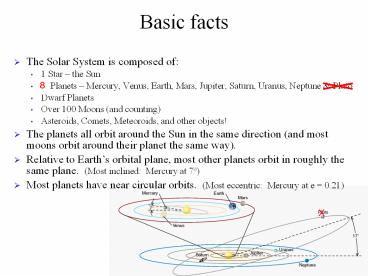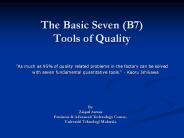Basic facts - PowerPoint PPT Presentation
1 / 14
Title:
Basic facts
Description:
... trapped by specific gravitational pulls from Jupiter and ... Comet Impacts. Will a comet (or asteroid) hit the Earth? 1994 Comet Shoemaker-Levy hit Jupiter. ... – PowerPoint PPT presentation
Number of Views:132
Avg rating:3.0/5.0
Title: Basic facts
1
Basic facts
- The Solar System is composed of
- 1 Star the Sun
- 9 Planets Mercury, Venus, Earth, Mars,
Jupiter, Saturn, Uranus, Neptune Pluto - Dwarf Planets
- Over 100 Moons (and counting)
- Asteroids, Comets, Meteoroids, and other objects!
- The planets all orbit around the Sun in the same
direction (and most moons orbit around their
planet the same way). - Relative to Earths orbital plane, most other
planets orbit in roughly the same plane. (Most
inclined Mercury at 7º) - Most planets have near circular orbits. (Most
eccentric Mercury at e 0.21)
2
Terrestrial vs. Jovian Planets
3
Stellar Debris
- Asteroids fragments of rocky objects
- Range in size up to 100 km in diameter.
- Irregularly shaped, and cratered.
- Similar in composition to outer layers of
terrestrial planets. - Comets small icy bodies (dirty snowballs).
- Large elliptical orbits can bring comets in close
to the Sun. - Recent studies suggest they are at least 50 rock
and dust. - Meteoroids specks of dust and rock similar in
composition to Asteroids, but much smaller (less
than 100 m in diameter). - We study small objects like these because they
have been untouched by evolution over time (good
indication of solar system composition at the
time of formation.)
4
- Most asteroids like within the asteroid belt,
between Mars and Jupiter. - Trojan asteroids share Jupiters orbit. These
asteroids are trapped by specific gravitational
pulls from Jupiter and the Sun. - Some asteroids have been pushed into elliptical
orbits by Jupiter, causing this to move closer in
to the Solar System. - Observations of asteroids suggest that they are
not completely solid, but rather a collection of
fragments which never completely reformed.
5
Comets
- Comets have highly elliptical orbits, bringing
them close to the Sun, but also very far away. - Change in distance causes change in heating.
- As a comet approaches the Sun, its ices sublimate
(change directly from solid to gas). - Comets form two tails
- Gas (ion) tail (type I)
- Ionized gas carried away by the solar wind.
- Generally points away from the Sun.
- Dust tail (type II)
- Dust loosened by vaporizing ice, pushed away be
solar wind. - Follows orbital path of comet.
- Coma halo of gas and dust surrounding the
nucleus. - Nucleus 10 100 km
- Coma 105 km
6
Comet Nuclei
- Comet nuclei
- Porous rock, irregular in shape.
- Ices (H2O, CO2, ammonia, etc.)
- Density 0.1 0.25 g/cm3
- As comet nears the sun, its surface fragments and
releases jets of material. - Probably faults or vents in surface of nucleus.
7
The Origin of Comets
- Long period comets (P gt 200 yrs.)
- Randomly inclined orbits.
- Random direction and revolution.
- Short period comets (P lt 200 yrs.)
- Orbits lie within 30 of the plane of the Solar
System. - Most revolve counterclockwise.
- Oort Cloud
- Spherical cloud of icy bodies.
- 104 to 105 AU in radius.
- Kuiper Belt
- Disk of icy planetesimals.
- 30 to 100 AU from the Sun.
8
Meteoroids
- Meteoroid Speck of dust and rock which
encounter Earths atmosphere and either burn up
or fall to the ground. (Most only about 1g in
mass). - Meteor Flash across the sky as the meteoroid
burns up. - Meteorite Remnant of a meteoroid that reaches
the ground.
Above atmosphere
In atmosphere
Hits ground
9
Meteor Showers
- As comets orbit the Sun, they lose material and
leave a trail. - As the Earth passes through that trail, the
particles fall towards Earth in the form of
meteor showers. - Meteor showers are designated by the
constellation from which they appear to be
originating.
10
Radioactive Dating
- Radioactive Decay process through which massive
particles naturally decay into less massive ones. - Radioactive Dating determining the age of an
object based on how certain particles have
radioactively decayed over time. - The Earth oldest samples suggest an age older
than 4.3 to 4.4 billion years. - The Moon lunar rocks suggest an age older than
4.48 billion years. - Mars meteorite samples discovered in the
Antarctic suggest an age older than 4.5 billion
years. - Meteorites suggest an age older than 4.6
billion years. - Our solar system is thought to be around 4.6
billion years old.
11
Comet Impacts
- Will a comet (or asteroid) hit the Earth?
- 1994 Comet Shoemaker-Levy hit Jupiter.
- Evidence of other impacts on the Moon and other
solar system bodies.
12
Evidence of Impacts on Earth
- Barringer Meteor Crater 25,000 years old and
1.2 km wide. - The Tunguska Event (30 June 1908) an impact in
Siberia thought to be due to an meteorite
exploding meters off of the ground.
13
The Extinction of the Dinosaurs
- Layer of iridium found in sediment all around the
world. - 65 million years ago.
- Iridium common in meteorites, but not on Earths
surface.
- Impact thought to have led to the extinction of
the dinosaurs. - As impact occurs, shocks and tsunamis would kill
nearby life. - Rock heated by impact, thrown into the air,
causing forest fires around the world. - Dust in atmosphere blocks sunlight for at least a
year. - CO2 released into atmosphere.
14
- Likelihood of impacts based on how much energy
they would release.





























